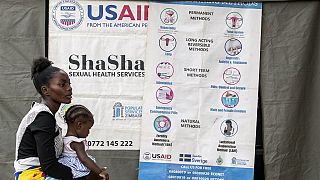Zimbabwe
A group of women run to meet a passing truck on the Harare to Bulawayo highway.
They are hoping to entice the drivers into buying the fruits of their harvest - colourful wild mushrooms.
It's rainy season and fungi appear from the damp soil.
Rich in protein, antioxidants and fibre, wild mushrooms are a revered delicacy and income earner in Zimbabwe, where food and formal jobs are scarce for many.
Locals walk into the bush to collect them to supplement their income.
But they must do it under the cover of darkness to avoid the landowners who would not welcome their presence, explains mushroom picker Diana Chiwara :
"This is the bush where wepick mushrooms, we wake up early morning around past 3 am and walk deep into this bush. We can't come late in the day because it’s restricted to be in this place. The owners of this place don't always allow people tocome and pick mushrooms here. So wecome early andwill behiding from them, so that by the time it’slunch time we are already leaving.”
Her pre-dawn trip to the forest marks just the beginning of a day-long process.
From the bush, Chiwara heads to a busy highway.
Using a knife and water, she cleans the mushrooms before joining the stiff competition of other mushroom sellers hoping to attract passing motorists.
There are thousands of varieties of mushrooms.
Some are perfectly safe to eat such as portobello, shitake and the common button mushroom found in supermarkets.
But many wild mushrooms can cause stomach upset or allergic reactions, or may even be fatally poisonous.
It is very difficult to tell edible and poisonous mushrooms apart.
It requires expert knowledge and training to learn which ones are safe to eat.
Those without training should not attempt to pick mushrooms for human consumption of any sort.
Here the expert knowledge and training is passed down through the generations, typically from mother to daughter.
Today, Polite Mugobo is heading out to collect mushrooms with her husband and son.
She says it's not a task for the faint hearted : “Sometimes we meet thugs and they steal everything from us. Sometimes the farm owners chase us from their land. So we try to do this while hiding, it’s tough. We also have to be careful so that we don’t get attacked by dangerous wild animals.”
The family team comb through the morning dew for shoot-ups under trees and dried leaves.
Once they have enough, they clean their bounty and arrange it in bowls to sell.
“We sell this mushroom for US$1 a bowl like this during the rainy season. Our customers regularly stop on highway to buy mushrooms. On a good day or during the weekend we go home with about US $20 - $15 each,” says Mugobo.
Women such as Mugobo are dominant players in Zimbabwe's mushroom trade, says Wonder Ngezimana, an assoc iate professor of horticulture at the Marondera University of Agricultural Science and Technology.
“Predominantly women have been gatherers and they normally go with their daughters. They transfer the indigenous knowledge from one generation to the other,” he says .
About one in four women who forage for wild mushrooms are often accompanied by their daughters, according to research carried out by Ngezimana and colleagues at the university in 2021. In “just few cases” — 1.4% — mothers were accompanied by a boy child.
“Mothers were better knowledgeable of wild edible mushrooms compared to their counterparts - fathers,” noted the researchers.
The researchers interviewed close to 100 people and observed mushroom collection in Binga, a district in western Zimbabwe where growing Zimbabwe's staple food, maize, is largely unviable due to droughts and poor land quality.
Many families in the Binga, which is over 8 hours driving from Harare, are too poor to afford basic food and other items.
So mushroom season is important for the families.
On average, each family made just over $100 a month from selling wild mushrooms, in addition to relying on the fungi for their own household food consumption, according to the research.
In large part due to harsh weather conditions, about a quarter of Zimbabwe's 15 million people are food insecure, meaning that they’re not sure where their next meal will come from, according to aid agencies.
Zimbabwe has one of the world's highest rates of food inflation at 264%, according to the International Monetary Fund.
Police routinely warn people of the hazards of consuming wild mushrooms.
In January, three girls in one family died after eating poisonous wild mushrooms. Such reports filter through each season.
A few years ago 10 family members died after consuming poisonous mushrooms.
To promote safe mushroom consumption and year-round income generation, the government is promoting small-scale commercial production of certain types such as oyster mushrooms.
But it appears the wild ones remain the most popular










01:03
Uganda: Victims of lightning strike buried
01:23
Spain: Flood survivors call for help, local govt criticised
01:34
Human Rights: Violence against women and girls in sports becoming systematic
01:00
Tasmanian court excludes men from women-only exhibition
02:13
Devastating floods in Cameroon: Thousands Displaced, Infrastructure destroyed
01:07
A year on, Libya is still rebuilding flood-hit Derna